We’re going to do something a little different this time. Remember our look at the alternate and “What Could Have Been” takes on Doctor Who? This time, we’re going to take a similar gander at Spider-Man’s black and white costume, which later led to the creation of the villain Venom. When it comes to the creation of the suit itself and the origin story of the villain it became associated with, the published product wasn’t the original plan. Let’s take a look!
FAN-FICTION INSPIRED
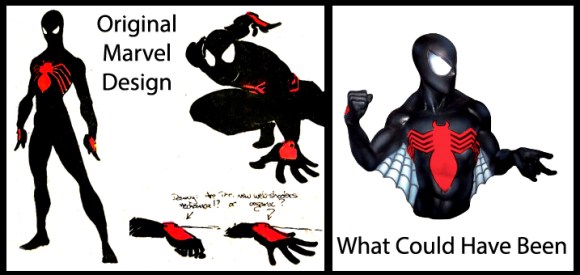
In the 1980s, Marvel Comics ran some competitions and try-outs for aspiring creators. In 1983, Spidey fan Randy Schueller sent in a suggestion about Peter Parker gaining a new costume created by Reed Richards (Mr. Fantastic of the Fantastic Four) and designed by fashionista Janet Van Dyne (the Wasp). This costume was basically the Venom suit we know today, except red and black and with the classic Spidey underarm webbing that Steve Ditko loved.
The costume would be stealthy and constructed of unstable molecule fabric (which the Fantastic Four and certain other heroes wear), in order to provide less interference with Spidey’s wall-clinging abilities than normal cloth. Its UMF nature also meant it wouldn’t tear in battle, which happened to Spidey now and then. The final touch was built-in web-shooters that responded to Peter’s thought commands, provided by Tony “I am Iron Man” Stark.

Now, the idea of putting Peter in red and black wasn’t a new one but rather a reversion to the old days. You see, in the first few Spider-Man comics, artist Steve Ditko meant for the classic costume to be black and red. He just added a bit of blue here and there to highlight texture. But a couple of issues down the line, the blue started overwhelming the black areas. Less than a year after his introduction, Spidey was now clearly wearing a red and blue costume.
Back to Schueller’s idea for a new Spidey costume. Marvel’s then Editor-in-Chief Jim Shooter liked the basic idea and design and contacted the fan. He paid Randy Schueller $220 for the idea and offered him a chance to write the story introducing it. Jim Shooter himself started writing stories for DC Comics when he was a young teenager, so it makes sense he would be up for hiring a fan who showed promise.
Randy accepted the deal, but further correspondence with Marvel frustrated him. As he later admitted, he realized that writing a comic book story and rewriting things to suit editors was more difficult than he’d imagined, and he finally gave up. In the meantime, Shooter worked with artists Mike Zeck and Rick Leonardi to design what would become Spidey’s new black and white suit.
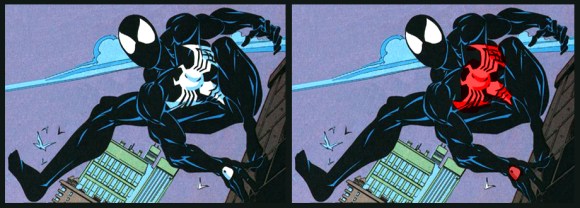
Marvel tweaked the costume a bit before they used it in a published comic. The red became white and the underarm webbing went away entirely. It was also decided not to make this costume a technological wonder donated to Spidey through the efforts of three other superheroes. But we were THIS close to seeing Spidey in a red and black costume that the Black Widow would have been proud of, rather than a monochromatic uniform. I still sometimes think I would’ve liked the red more.
ALIEN ORIGIN AND JULIA CARPENTER

In Amazing Spider-Man #251, our hero walked into a futuristic version of Stonehenge and was teleported away to some far off location in deep space. In Amazing Spider-Man #252 (May, 1984), Spidey emerged from the same structure weeks later, now sporting this black and white costume that had built-in web-shooters, altered its appearance based on his thoughts, and created little invisible pockets to hold stuff like his camera. Readers were told that this costume was a creation of alien science, obtained by Peter on another world. To learn more, they needed to read the crossover story Marvel Super Heroes Secret Wars that was about to be published.
SPIDER-MAN: “Wait, Sizzler, why did an alien origin make more sense than saying Mr. Fantastic, a friend of mine, gave me a gift?”
Peter, shut up. I’m doing a column here.

SPIDER-MAN: “No, but – Sizz, seriously. Alien costume? Sure, by 1984 I’d had a few random encounters with Thanos, Adam Warlock, the Silver Surfer and the Stranger. Plus there was that one early adventure where I thought I stopped an alien invasion and it later turned out to be Mysterio and the Tinkerer wearing alien costumes because. . . reasons. And I’ve hung out with Thor several times, who’s sort of a god AND an alien – which is just greedy. But any time I had an adventure with aliens, the point was me as a fish out of water. Seems against my atmosphere to give me a costume with an alien origin rather than saying it was created by a strange experiment, like 90% of my enemies.”
I know that and I agree, but Shooter was writing this big Secret Wars crossover that took place in space on “Battleworld” and he probably figured to drum up reader interest by saying your new costume came from said world of battle.
SPIDER-MAN: “Oh, I get it. At least this is the only time I was given a costume just to tie-in to a crossover event, right?”
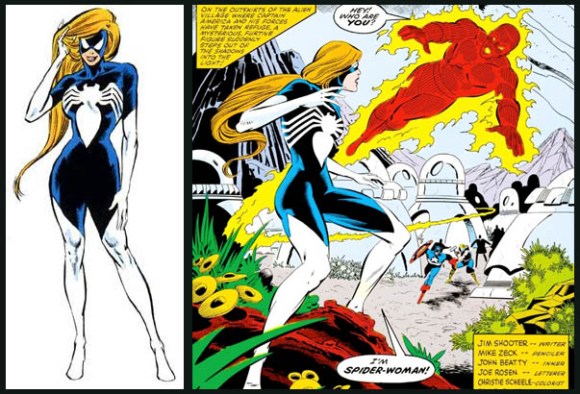
Um, yeah. So, about six months after the black costume debuted, it origin started unfolding in Marvel Super Heroes Secret Wars #7 In that issue, Julia Carpenter made her full debut as the second hero to be called Spider-Woman, sporting a familiar black and white costume.
SPIDER-MAN: “Wait, Julia wore my black costume before me?”
Historically, no. Retroactively, yes. It’s not EXACTLY your costume. It lets her hair and mouth show, plus there are feminine style long boots and gloves. All to make sure that we know she’s a lady, in case her body wasn’t a clue. This was just the first step towards the alien suit.
In Marvel Super Heroes Secret Wars #8, Spidey’s outfit was pretty damaged. Then, while he and the heroes were hanging out in an alien fortress, Thor told him dude, there is verily a machine in the next room that constructs fabric according to your thoughts. Spidey went into the room and it turned out there were a LOT of machines, none of which were conveniently labeled “I MAKE YOU CLOTHES, FOOL.”

So Spidey tried one machine that wound up releasing a black orb of goo. Like the scientist he is, Peter touched it without hesitation. It expanded, destroying the fabric he wore, forming into a costume similar to Julia’s. Evidently, Pete had been impressed with her look and the alien suit sensed this.
SPIDER-MAN: “Isn’t it confusing that Marvel dressed us both that way? The Superman family is literally family. But Spider-Woman II and I barely interacted at all during the Secret Wars and then we didn’t have anything to do with each other for years. Why link us with near-identical outfits?”
It’s definitely odd. I always thought you two needed a closer relationship. At least that did happen eventually, when she became Madame Web. But we’ve gone on another tangent. The point is you got yourself this funky costume that you assumed was thought-controlled fabric created by alien tech.

A few years back, I discussed this black costume with fashion authority Tim Gunn, known for his excellent books and from TV shows such as Project Runway and Under the Gunn. Tim is a huge fan of Spidey’s classic look, but his immediate reaction to seeing the black costume was, “Disappointing. . . I also think it’s too literal. . . A little too obvious for me.”
I completely agree with Tim. When I was a kid, I thought the costume was cool because it was black and sleek. Nowadays, I don’t think there’s much to it other than bug-eyes and a giant spider, whereas Ditko’s costume design is unique. Also, I am a big believer that the costume should reflect the personality and atmosphere of the character. Spidey has dark adventures sometimes, but is not by nature a dark guy. Even when he gets gloomy from time to time, he figures tomorrow will be a better day and will crack a joke about his situation in life.
SPIDER-MAN: “But didn’t the alien costume bring out my dark side? ”
Spider-Man, you ignorant slut. Have you so easily forgotten the 1980s? True, in later adaptations, the alien costume did have that effect. But in the original comics when you wore this suit, that was NOT the case. You were exactly the same in your personality and the only ill effect caused by your new wardrobe was that you felt tired more often. So no, the black costume doesn’t reflect a change in you.

Anyway, as time when on, things with the costume got noticeably weird. Finally, Spidey asked Reed Richards to run some tests and he discovered it wasn’t alien fabric but an alien “symbiote” (which is very similar to a symbiont except spelled differently for some reason and apparently more parasitic). This was a creature living off of Peter and trying to permanently attach. Mr. Fantastic quickly imprisoned the alien and sent Peter on his way.
Pete wore the classic red and blue suit for a bit, but then his on-again, off-again girlfriend Felicia Hardy AKA the Black Cat gave him a cloth version of his black costume as a present. Her reasons? She thought the design was sexier. So more often than not, Spidey still wore this black design for the next few years 1988.
ENTER: EDDIE BROCK
The alien costume later escaped and attempted another connection with Peter, but he fought it off and seemingly killed it in a church (there’s a metaphor there, I’m sure). Then in Amazing Spider-Man #299, Pete’s wife Mary Jane Watson was terrorized and brought to tears by a new enemy. In Amazing Spider-Man #300, Peter confronted this villain: Eddie Brock, who had bonded with the alien symbiote to become Venom. This adventure led to Spidey burning his black suit and returning to his red and blue standard.
Two years before, Spidey’s longtime friend NYPD Captain Jean DeWolff was found dead in her bed. The web-slinger and Daredevil worked together to track down the killer, a man called Sin-Eater. At one point, it seemed that the killed was revealed and arrested, but the two vigilantes discovered otherwise and brought in the real Sin-Eater.
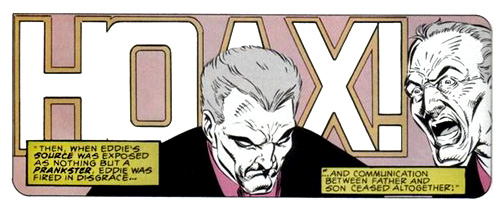
Now, Eddie Brock explained that these events had changed his life. He had helped bring about the false Sin-Eater’s arrest, after publishing an exclusive interview about his crimes. But then Spider-Man and Daredevil’s actions labeled his story a hoax. He was humiliated, blacklisted from major news outlets and forced to work in trashy tabloids. He had contemplated suicide and gone to a church for guidance, only to find the symbiote.

Learning Peter’s identity and gaining his powers from the alien, Eddie now wanted vengeance against the hero he held responsible for ruining his life. He was obviously really angry about those tabloids, too, because he told Spidey, “You may call me Venom, for that’s what I’m paid to spew out these days.”
SPIDER-MAN: “That’s a lame reason for the name.”
I know. Remember, this was the grim 1980s leading into the strange 1990s. It was all the rage to name characters after random objects, adjective or verbs. You had soldiers named Cable, villains named Conduit and Bane.
Now with Venom’s design, it would have been a natural choice to make him identical to Spidey’s black look. But artist Todd McFarlane made Venom’s enormous physique antithetical to Spidey’s agile, acrobatic build. The symbiote could alter its appearance, so McFarlane gave him a monstrous appearance, growing a visible mouth on his mask with elongated teeth.
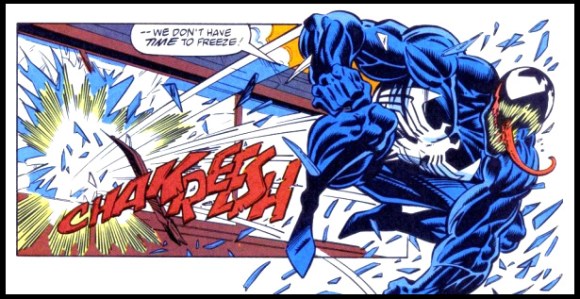
Artists Erik Larsen and Mark Bagley took Venom a few steps further, giving him fangs and an elongated tongue. Venom is now truly a distorted reflection of Spider-Man. While I don’t think the simple monochromatic design worked for Peter, it does work for Eddie Brock, who refuses to see the world in anything beyond his own black and white morality.

Despite his popularity as a villain, Venom’s origin as a disgraced journalist who blamed Spider-Man for his own failures didn’t always mesh with folks. Over the years, his backstory was given greater context by writers David Michelinie and Paul Jenkins. In adaptations, Eddie Brock is usually reinterpreted as someone who personally knows Peter and develops animosity towards him and Spider-Man over the course of several encounters, only later bonding with the alien.
The best version of Venom’s origin and animosity presented, in my own opinion, was in the cartoon The Spectacular Spider-Man, developed by Greg Weisman and Victor Cook. They even gave a decent explanation for why he would call himself “Venom,” saying he was determined to be a poisonous element in the Peter Parker’s life.
And now we come to our biggest What Could Have Been. Namely. . .
WHO WAS VENOM SUPPOSED TO BE?
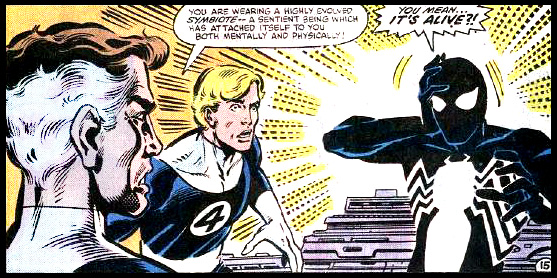
The black costume was never intended to spawn a villain. The only plot-twist Jim Shooter and writer Tom DeFalco envisioned was Spider-Man learning it was a weird parasite and promptly trying to cage or kill it.
SPIDER-MAN: “That really isn’t much of a plot twist. ‘Oh no, my costume wants me to wear it permanently!’ I mean, we took care of it in two pages and then I went back to using fabric. It’s not like the alien spoke or did anything threatening to me, during that initial story. It was just. . . icky.”
Very true, Peter. And after it seemingly died in that church, Marvel was ready to let the symbiote story end. But David Michelinie had other plans. It had been seen that the alien could transfer Spider-Man’s powers to a new host and that it didn’t set off his danger-warning “spider-sense.” Michelinie thought this could be used to create a new archenemy. Starting in 1986, he wrote a couple of stories where Peter Parker suffered random attacks by an unseen person who surprised him then always slipped away. Peter was understandably worried that his spider-sense wasn’t working, since normally it was sensitive enough to let him know if he were being followed or watched by a camera.

Michelinie’s plan was to reveal that the hidden enemy was a woman. She had once been married and with a baby on the way. But then she and her husband were nearby one of Spider-Man’s public battles in New York and a driver, distracted by the fighting, struck them with his car. Her husband died and the trauma caused her to lose her child. Devastated, the woman was consumed with grief. Eventually, she encountered the barely alive symbiote, which sensed her anger towards Spider-Man and bonded with her. Now she wanted nothing more than vengeance for the loss of her family.
Edutir Jim Salicrup definitely wanted a new archenemy to debut in Spidey’s 300th issue, one that was deadly, vicious and ominous. But he didn’t think readers would accept a woman would be such a formidable threat to our hero. So, Michelinie had to change the story and that’s how we got Eddie Brock.
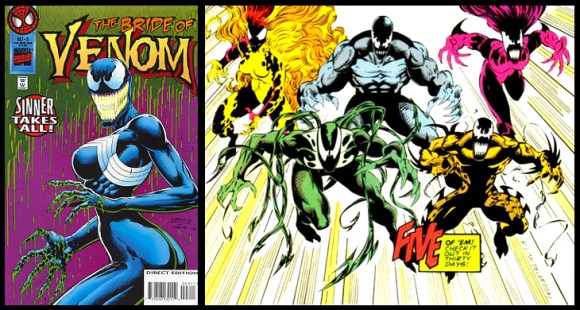
Still, we have to wonder “what could have been?” What if Michelinie had been allowed to make Spider-Man’s new enemy a woman who’d lost her family, whose anger against the hero was something we could understand? Yes, there have been women characters in the comics who were bonded to their own symbiotes. But none of them were meant to stand as true archenemies against the web-slinger. In fact, I’m hard-pressed to think of a male superhero who’s archenemy is a woman, and along with that, one whom he isn’t romantically drawn to. Michelinie’s character could’ve been something different indeed.
Next week, we’ll l focus on what has happened with the other incarnations of Venom. Eddie Brock hasn’t been the suit’s only villainous host, you know.
Alan Sizzler Kistler is an actor/writer and the author of Doctor Who: A History.
Are you following The Mary Sue on Twitter, Facebook, Tumblr, Pinterest, & Google +?









Published: Jan 23, 2014 12:29 pm